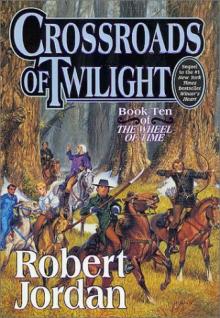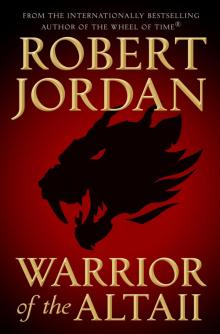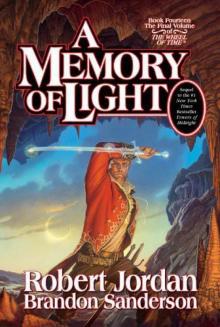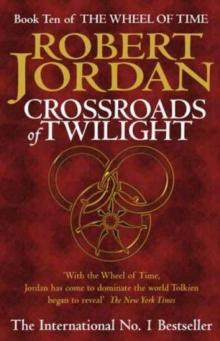- Home
- Robert Jordan
The Wheel of Time Companion Page 8
The Wheel of Time Companion Read online
Page 8
Any candidate who had the backing of three Sitters, or any six other sisters, could in effect demand that a vote be taken. In truth, when a candidate was proposed by non-Sitters, this in itself constituted such a demand. This was a dangerous procedure, however; if she failed on the third vote, she and her proposers were almost always exiled to separate places for terms that could run from a few years to life, for such demands were considered disruptive and a source of contention.
Strangely, a woman did not actually have to be Aes Sedai in order to be raised Amyrlin. Perhaps because it seemed obvious that she must be, not one word in the laws describing the election or raising of an Amyrlin said that she had to be. On the other hand, the wording of a number of laws—“the Amyrlin as Aes Sedai,” etc.—made it clear that the Amyrlin Seat was Aes Sedai.
On being raised Amyrlin, a woman left her old Ajah. The only vestige of it would be if she had a Warder, indicating she was not Red, or if she had more than one, indicating that she was Green. Otherwise, she was supposed to be “of all Ajahs and none.” In fact, of course, Amyrlins always remained who they were before and retained many of the beliefs and goals of their old Ajahs; some of the better Amyrlins overcame this, and so did some of the worst. Some of the best behaved as if still of their old Ajah.
Supposedly the Amyrlin had absolute authority, and in fact she did—sort of. An Amyrlin’s actual power depended in large part on her real support in the Hall of the Tower, and, among other things, on her own drive and personality. Although the facts were buried deeply in White Tower records, some Amyrlins were no better than puppets for the Hall, or for factions within the Hall.
While the Amyrlin Seat could declare the Tower at war by decree, few had ever done so, preferring to ask—in some cases, just short of demand, or even not short of demanding—that the Hall declare war. While the lesser consensus was much easier to achieve than the greater, the successful prosecution of a war required good, solid backing from and in the Hall of the Tower, something that generally had been easier to obtain in these cases when the Hall had been asked. Then, too, historically, the Hall had been slower and more reluctant to go to war than the Amyrlin—not always the case, but more often so—and an Amyrlin who declared war and then found out that the Hall did not back her was in a fine fix.
An Amyrlin was absolute ruler insofar as she could gain consensus in the Hall, whether the greater or the lesser. She could decree almost anything, and her decrees had the force of law, but many of those could be overturned by the greater consensus, or at least made into only so much hot air, and in most important things she needed the Hall’s approval. The purse was a way the Hall could balk an Amyrlin, since if anything she decreed required money to be carried out, the Hall had to vote the funds to finance it. Some of the Amyrlins who were reduced to puppets fell to this. Appropriations needed only the lesser consensus, which still meant two of the three Sitters present.
The Hall could also overturn an Amyrlin’s decree, not merely let it die through lack of action. This required the greater consensus, and it was inevitably a prelude to a power struggle. Some of these ended with the Amyrlin a puppet of the Hall. An Amyrlin had the authority to unchair any Sitter or all of them, but a wise Amyrlin did this extremely sparingly. An Ajah could choose the same Sitter again as a rebuke to the Amyrlin. An Amyrlin who unchaired the entire Hall and had the same women all chosen again, or even a significant number of them, very likely found that her real power as Amyrlin was at an end. An Amyrlin could decree any penance for any sister, including Sitters, short of stilling, right up to the most serious punishment of a public birching and/or exile. Some Amyrlins had used this to impose their will by fear, in effect, while others had had the decree backfire on them, causing the Ajahs to turn against her, and with them, of course, the Sitters.
Some Amyrlins were recorded who had taken public penances on themselves for rather vague reasons, according to the Chronicles. At least some of these women in fact were in a precarious position with respect to the Hall, and these penances were a way of regaining support. The Hall could not punish the Amyrlin, but if she took it on herself, it could appease the Sitters to a considerable degree.
Amyrlin, the. See Amyrlin Seat
Amys. A Wise One of the Nine Valleys sept of the Taardad Aiel. She was originally Far Dareis Mai and became the Wise One of Cold Rocks Hold. She was first-wife of Rhuarc, the clan chief of the Taardad, and Lian (Aviendha’s sister-mother) was her sister-wife. Because she was a Wise One, her sister-wife was the roofmistress of Cold Rocks Hold; she could not hold both positions. Amys was the mother of some of Rhuarc’s children; she was also sister-mother to Aviendha, since she had adopted Lian as her first-sister. She had sharp blue eyes and prematurely white hair; her hair had been a very light blond when she was young, but turned white when she was in her early thirties. She was about 5'8" tall. Amys could channel and was a dreamwalker. She taught Egwene about Tel’aran’rhiod. Amys, along with Bair, Melaine, Sorilea and some others, either knew that Aviendha saw herself inside the rings at Rhuidean fated to fall in love with Rand, or else knew that the plan was to use Aviendha to tie Rand to the Aiel by giving him an Aiel wife. Amys was among the ninety-three strongest Wise Ones who set out from Cairhien for Dumai’s Wells to rescue Rand. On the way there Amys challenged Sorilea’s leadership and they worked out a compromise. Sorilea retained the leadership, but Amys was often consulted. She suffered the birth pangs during the adoption ceremony of Aviendha and Elayne. She fought in the Last Battle near Shayol Ghul.
Anaiya Carel. An Aes Sedai of the Blue Ajah and the rebel contingent, with a strength level of 15(3). Born in 868 NE, she went to the White Tower in 883 NE. After eight years as a novice and seven years as Accepted, she was raised to the shawl in 898 NE. About 5'6" tall, with dark hair and a blunt face, she was a plain-looking, motherly woman. Her smile was her only beauty. She had a great fondness for ruffles. She was very astute politically, and a first-rate organizer. She was very good at Healing; she once Healed Moiraine after Lan rode a horse to death, and nearly ran himself to death carrying Moiraine to her. She accompanied Siuan to Fal Dara, and tested Egwene to try to determine if Egwene was a Dreamer. She was also a part of the circle that Healed Mat of the connection to the Shadar Logoth dagger. After Siuan was deposed and stilled, Anaiya went to Salidar, where she became part of the council that ruled there until a Hall of the Tower was selected, and she helped to choose Egwene as Amyrlin. She swore personal fealty to Egwene after Egwene learned that the council had sent spies to the White Tower. Anaiya was a friend of Janya. Her Warder was Setagana; both were murdered with the use of saidin by Aran’gar.
Anaiyella Narencelona. A High Lady of Tear and a Darkfriend. She was willowy and darkly beautiful, but her frequent simpering lessened her beauty. Rand summoned her to join his forces in the fight against the Seanchan; she was not pleased to be on the field of battle. Her Master of the Horse was killed in the fighting. Rand then took her to the Sun Palace of Cairhien and ordered her to go with Darlin and Weiramon to Arad Doman. Without permission, she and Weiramon traveled to Tear, angering Rand. After he returned from Dragonmount, Rand identified Anaiyella as a Darkfriend and exiled her.
Anan. A family in Ebou Dar. See Frielle, Jasfer, Marah, Ross and Setalle Anan
Ananda. An Aes Sedai of the Yellow Ajah. She was slim with long black hair. Min saw an aura around her that indicated that she would die. She did so, in the Tower fighting when Siuan was deposed.
Anangore. The ninth-largest city in Seanchan.
Anarina Todande. A former queen of Altara. Her family ruled for five generations, the longest on record, but she was a capricious ruler at best and incompetent at worst. Anarina drained the national treasury and impoverished House Todande; she was deposed and murdered, and her House never recovered. No House after Todande held the throne of Altara for more than two generations until Beslan became king after Tylin’s death.
Anasai of Ryddingwood. A favorite poet of Moiraine.
Anath
Dorje. Tuon’s Truthspeaker, or Soe’feia; she was actually Semirhage in disguise. Slender, and tall even for a man or an Aiel, she dressed in unrelieved black and had a contemptuous air. Her charcoal-dark face, framed by wavy, short black hair, was beautiful but her large black eyes seemed to pierce like awls. See also Semirhage
Ancient and Honorable League of Nets. The guild of fishermen in Ebou Dar. A member wore a double earring in his left ear. Stones in the earring indicated how many ships he owned besides the one that he captained. There were no women in the league.
Ancient and Worshipful Guild of Stablemen. The guild for stablemen in Ebou Dar.
Ancarid. The place in Seanchan where Furyk Karede was born.
Ancohima. The Ogier-built capital city of Aelgar, one of the Ten Nations after the Breaking.
Andahar, River. A river in Tarabon flowing west-southwest into Tanchico Bay.
Andaya Forae. A Taraboner Aes Sedai of the Gray Ajah and the loyalist contingent, with a strength level of 24(12). Born in 901 NE, she went to the White Tower in 918 NE. After ten years as a novice and ten more as Accepted, she was raised to the shawl in 938 NE. She was 5'5" tall, with hazel eyes and light brown hair, no longer worn in Taraboner braids, that fell gleaming down her back. Elaida thought of her as neither particularly slim nor particularly short, but Andaya reminded her of a sparrow about to hop from limb to limb. Even her smile seemed sparrow-like to Elaida, perhaps because of the way she held her head. She was an unlikely-appearing negotiator, but in fact she was one of the best, with a well-earned reputation. Serancha Colvine, head of the Grays, ordered Andaya to serve on Elaida’s advisory council when Elaida was first raised to the Amyrlin Seat, as both Serancha and Andaya doubted the legality of Siuan’s removal and thought it best to keep an eye on Elaida. Andaya thought the world was hanging by a thread and that it was useless to waste precious time with idle speculation, “prattling about supposed logic” or “chattering over what every fool and novice knows.” In 999 NE she was surprisingly chosen as Sitter for the Gray in the Tower to replace Varilin Zanaire.
Andaya Murasaka. An acrobat with Valan Luca’s show. She was one of six purported sisters that Luca hired away from Sillia Cerano. She had blue eyes and almost white blond hair.
Ander Corl. A bootmaker in the town of Taien in the Jangai Pass. He, his wife and his brother-in-law survived the Shaido attack on their town.
Ander Tol. A skinny, toothless turnip farmer from the south of Cairhien who gave Rand and his companions a ride into Cairhien after the bubble of evil attacked the rebel Cairhienin camp and Fain slashed Rand with the dagger from Shadar Logoth.
Andere. A Malkieri who worked for a time as a Kandori soldier. When he greeted Lan and Bukama at the gates of Canluum, Bukama berated him for swearing to a Kandori lord. Years later, after hearing that Lan was riding across the Borderlands, Andere joined Lan on the Plain of Lances. He fought in Lan’s army at Tarwin’s Gap in the Last Battle.
Anderly, Sashalle. See Sashalle Anderly
Andhilin. A Maiden of the Red Salt Goshien. Her name appeared on Rand’s list of women who died for him.
Andiama. A Tairen noble House. See Estean and Torean Nelondara Andiama
Andil. A woman who worked in the kitchen of the Sun Palace in Cairhien. She fussed over Karldin and Loial when they arrived there.
andilay. A root used medicinally to relieve fatigue, to clear the head and to treat sore muscles.
Andomeran, Rianna. See Rianna Andomeran
Andor. One of the largest and oldest nations of the land. Its capital was Caemlyn. The sigil of Andor was a rampant white lion: the White Lion. Its banner was a white lion rampant on a field of red. Its battle cry was “Forward the White Lion!”
Andor was founded circa FY 994 by Lady Ishara and Lord Souran Maravaile, then holding little more than the city of Caemlyn, with Ishara crowned as the first Queen of Andor, which was one of Hawkwing’s provinces. She became queen rather than he king for the simple reason that she was native to the province, while he was from the Borderlands, most probably from Jaramide. In addition to facing opposition from those who wanted to reestablish the nation of Caembarin and those who wanted to seize the city for a reestablished nation of Esandara, they also confronted men and women who wanted to take all of Hawkwing’s empire, and those who merely wanted to create a new nation of their own as well. Ishara followed a policy of slow assimilation, only gradually increasing her holdings and never moving on until she was sure that what she had taken was firmly in her grasp. Andor grew to stretch from the Mountains of Mist to the River Erinin. Its population was approximately ten million people. The Two Rivers lay within Andor, although Two Rivers folk ignored the fact.
Prior to the recruitment and changes made by Gaebril/Rahvin, the Queen’s Guards were the only permanent formation of the Andoran army, providing not only a bodyguard for the Queen, but some policing in Caemlyn, border guards, and patrols to keep order in the countryside. They then numbered perhaps ten thousand men in total. The Queen’s Guards seldom went farther west than Breen’s Spring unless called for. Gaebril/Rahvin replaced most of the men in Caemlyn with his own recruits, increased the numbers of the Guards, and recruited another formation called the White Lions. Many men loyal to Morgase left the Guards, disliking the new men and her apparent willingness to let Gaebril shove them into the organization. Most men loyal to Morgase who remained in the Guards were sent out of the city, a good many into Cairhien, others west. With Gaebril’s death, many of the men recruited by him deserted, and many others were purged later, leaving a much reduced number stationed in Caemlyn; many became mercenaries in Cairhien, supporting the claims of Toram Riatin.
The man in charge of training for the Queen’s Guards bore the title of Master of the Sword. A high degree of skill with various weapons was considered a prerequisite for the job.
The uniform of the Queen’s Guard included a red undercoat, gleaming mail and plate armor, a brilliant red cloak and a conical helmet with a barred faceguard. High-ranking officers wore knots of rank on their shoulder and golden lion-head spurs. The Captain-General had four golden knots on the shoulder, an ordinary captain had three, a lieutenant had two and an under-lieutenant had one. The Andoran salute was an arm across the chest. When Elayne arrived in Caemlyn to claim the throne, she discovered that the Guards, in Caemlyn at least, were a shell of a few good men and too many of Gaebril’s shoulderthumpers and toughs. She appointed Birgitte, now Lady Birgitte Trahelion, as Captain-General of the Guards and set her to rebuild them, beginning with mercenaries and Hunters for the Horn, though these were temporary measures. They also created a new unit, the Queen’s Bodyguard. It was composed of women, although it was led by a man for a brief period. The uniform was basically the same as the Queen’s Guards: a red coat with a white collar and lapels, but with additions and changes. The white-collared crimson coats were silk, and altered to fit and hang better on women. There were also tight scarlet breeches with a white stripe up the outside of the leg, a bright red hat with a long white plume lying flat on the wide brim, and a wide red sash edged with snowy lace and with White Lions marching on it, worn slanted across the chest. Pale lace decorated the neck and cuffs, and snug black boots, waxed till they shone and turned down below the knee, completed the uniform.
In some parts of Andor, men wore flowers (or a flower) in their hair while courting. Unlike in most other lands, in Andor marriages between noble and commoners were not considered that unusual, although not that common, either. Royals had married commoners without comment inside Andor, at least, but that custom was looked upon as odd at best in other countries, even where the occasional noble had wed a commoner.
The royal succession in Andor was from mother to daughter. If there was no daughter, the noblewoman who could claim the most lines of descent from Ishara gained the throne. This succession was usually, but not always, peaceful.
Ishara sent her daughter to the White Tower in order to gain the Tower’s acquiescence in, if not outright support for,
her actions. Her successors followed, and by the end of the War of the Hundred Years both this and the succession in the female line had taken on the form of tradition. It was unclear precisely when these things became a matter of law, but they were so by the end of the war.
Naturally following the nature of the royal succession, titles also descended normally from mother to daughter, as did the largest part of property. Only when there was no daughter did a title descend to a son. A man who had thus inherited also left his main title and properties to his eldest daughter, though sons and other daughters could, of course, inherit smaller properties, and were nobility. Among the nobility, thus, most property and most land were in the hands of women.
Among commoners this rule did not hold. Inheritance was divided among sons and daughters, a daughter’s share, or part of it, often going with her when she married. This part was her property, not her husband’s, and it was her right to dispose of it as or leave it where she would, just as her husband could leave his property where he would. It was common in some areas for husbands to leave their property to their sons and wives to their daughters, though this was by no means a rule and was not followed in all circumstances.
Andor and Tear were major suppliers of grain and foodstuffs to Cairhien. Andor also was a major source of iron, and iron and steel products; these were considered the best available. Andor also produced bronze and copper. Gold, silver and copper were mined in the Mountains of Mist, though less of the gold and silver came from Andor than from other countries. Andor was considered to have the best bellfoundries, second possibly only to Arafel, and certainly the most numerous except for Arafel. Andor was a supplier of beef, mutton, wool, linen, woven goods and leather, although theirs was not generally considered as fine as Illianer leather. Two Rivers tabac was accounted the best to be found; it was known even in the Aiel Waste. Andor was considered to have good breeding stock for horses, though they were not generally considered as good as Tairen. Shortly before the Last Battle, alum of the first quality was discovered in Andor. Previously, Ghealdan was the only supplier of first-quality alum, while Tear and Arafel supplied a much inferior second-quality. With the arrival of refugees from elsewhere, glassmaking started to become a major industry, as did dyes and dyeing because of the alum.

 Conan the Unconquered
Conan the Unconquered Conan the Triumphant
Conan the Triumphant The Eye of the World
The Eye of the World The Great Hunt
The Great Hunt Conan the Victorious
Conan the Victorious The Dragon Reborn
The Dragon Reborn The Fires of Heaven
The Fires of Heaven Winter's Heart
Winter's Heart Lord of Chaos
Lord of Chaos The Shadow Rising
The Shadow Rising Conan the Defender
Conan the Defender The Strike at Shayol Ghul
The Strike at Shayol Ghul The Path of Daggers
The Path of Daggers A Memory of Light
A Memory of Light Knife of Dreams
Knife of Dreams Crossroads of Twilight
Crossroads of Twilight Conan the Invincible
Conan the Invincible The Gathering Storm
The Gathering Storm Warrior of the Altaii
Warrior of the Altaii A Crown of Swords
A Crown of Swords The Wheel of Time
The Wheel of Time Towers of Midnight
Towers of Midnight Conan Chronicles 2
Conan Chronicles 2 Conan the Magnificent
Conan the Magnificent New Spring
New Spring What the Storm Means
What the Storm Means A Memory of Light twot-14
A Memory of Light twot-14 New Spring: The Novel
New Spring: The Novel Towers of midnight wot-13
Towers of midnight wot-13 A Memory Of Light: Wheel of Time Book 14
A Memory Of Light: Wheel of Time Book 14 A Crown of Swords twot-7
A Crown of Swords twot-7 Lord of Chaos twot-6
Lord of Chaos twot-6 The Great Hunt twot-2
The Great Hunt twot-2 The Shadow Rising twot-4
The Shadow Rising twot-4![Wheel of Time-11] Knife of Dreams Read online](http://i1.bookreadfree.com/i1/04/03/wheel_of_time-11_knife_of_dreams_preview.jpg) Wheel of Time-11] Knife of Dreams
Wheel of Time-11] Knife of Dreams The Dragon Reborn twot-3
The Dragon Reborn twot-3 The Wheel of Time Companion
The Wheel of Time Companion The Fires of Heaven twot-5
The Fires of Heaven twot-5 Prologue to Towers of Midnight
Prologue to Towers of Midnight The Path of Daggers - The Wheel of Time Book 8
The Path of Daggers - The Wheel of Time Book 8 The Path of Daggers twot-8
The Path of Daggers twot-8 By Grace and Banners Fallen: Prologue to a Memory of Light
By Grace and Banners Fallen: Prologue to a Memory of Light Crossroads of Twilight twot-10
Crossroads of Twilight twot-10 The Gathering Storm twot-12
The Gathering Storm twot-12 Winter's Heart twot-9
Winter's Heart twot-9 Knife of Dreams twot-11
Knife of Dreams twot-11 New Spring: The Novel (wheel of time)
New Spring: The Novel (wheel of time)